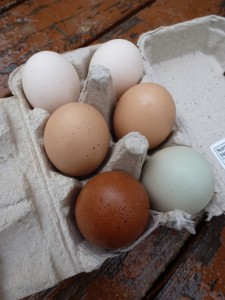 Eggs are the single most versatile ingredient in the kitchen.
Eggs are the single most versatile ingredient in the kitchen.
Think about the many diverse preparations that are based on eggs. Of course there are scrambled, fried, poached, coddled, shirred, hard-cooked, devilled, and pickled eggs, and yes there are omelettes and flans and frittatas, but there are also custards like crème brûlée and crème caramel, ice cream, sauces like mayonnaise and hollandaise, and sweets like meringue and angel food cake. Eggs are endlessly mutable because they contain two of the most fundamental building blocks of food – protein and fat – in relatively concentrated, isolated forms, in the whites and yolk respectively.
This post covers some fundamental egg info. Subsequent posts will discuss specific preparations and techniques.
How a Chicken Makes an Egg
These are my own words, but I learned every detail in this section from the egg chapter of Harold McGee’s On Food and Cooking, which is some of the most inspired food writing I’ve ever read.
 The eggs in our kitchen begin as single, living, germ cells in a hen’s ovary. Believe it or not, you can usually see this single cell when you crack an egg: it is a tiny white disc floating on top of the yolk.
The eggs in our kitchen begin as single, living, germ cells in a hen’s ovary. Believe it or not, you can usually see this single cell when you crack an egg: it is a tiny white disc floating on top of the yolk.
As the hen matures, each germ cell gets coated with a white, primordial yolk. Once the hens reach laying age, around 4-6 months, these germ cells will start to emerge one by one from the ovary surrounded by full-fledged yolks.
Red Spots on Egg Yolks. As a bit of a tangent, the red spot that sometimes appears on yolks does not indicate that the egg has been fertilized. It is simply the result of a small blood vessel in the ovary bursting.
The process of converting the yolk to an egg takes about 25 hours. From the ovary, the yolk travels along the 2-3 foot long oviduct, which secretes egg white onto the yolk in four layers, alternating thick-thin-thick-thin. The first layer of thick white is twisted by rifled grooves in the oviduct to become those little bundgy cords that keep the yolk centred in the finished egg. These cords are called chalazae (singular chalaza).
Once the whites have been secreted onto the yolk, two anti-microbial protein membranes are formed around the whites.
After two or three hours in the oviduct, the egg passes into the uterus. For the next five hours, the hen’s body pumps water and salts into the egg. Then calcium carbonate and protein are secreted onto the egg to form a porous shell. Finally a cuticle is applied, which temporarily blocks up the pores in the shell to prevent bacterial incursion. The cuticle also gives the egg its colour, which is determined entirely by the genetics of the hen, not environmental conditions or feed.
The egg is laid blunt end first (I don’t know why I find that so interesting), and is initially the same temperature as the hen’s body. As it cools the contents shrink, and those two anti-microbial membranes are pulled apart to form an air pocket at the blunt end of the egg. Another adorable detail: this little pocket provides the first mouthful of air to the nascent chick hatching from the egg.
Buying Eggs
The conditions in intensive, industrial egg operations are appalling, so I go out of my way to purchase eggs from local farmers who give their chickens room to live and allow them to (as Joel Salatin says) express their chickenness. At Elm we purchase about 60 dozen eggs every week from Four Whistle Farm. Other local suppliers include Sunworks (available at the Strathcona market) and Purnima (available at Planet Organic).
Despite conventional wisdom, yolk colour alone is not sufficient to know how a laying hen has been treated. In the height of summer, happy, healthy hens certainly produce yolks with a deep yellow-orange colour, but this can also be achieved by feeding unhappy chickens things like marigold petals. Eggs from industrial operations often have a rich yolk colour, but I still prefer to buy from Four Whistle because I know how the chickens are kept.
Storing Eggs
AHS will beg to differ, but it’s not dangerous to store eggs at room temperature. In fact throughout much of the world eggs are routinely stored at room temperature, whether in home kitchens or restaurant kitchens, or even grocery stores. Eggs do, however, age much, much faster at room temperature than they do in the fridge. As an egg ages water evaporates through the porous shell, making the white shrink and the air pocket grow. The protein structures in the white also become increasingly slack. This is most noticeable when we make fried or poached eggs. Fresh eggs will keep a relatively compact form when cracked, while older eggs will slough and run across the griddle or poaching liquid.
The photo below shows two egg of different origins and ages: the egg on the left is from Four Whistle, and was less than a week old when the picture was taken, while the egg on the right is from Superstore, and is more than two weeks old. First you can see the dramatic difference in yolk colour. The thick white on the left egg is much more compact, while on the right the white has loosened and is spreading across the plate.
These I think are the most basic facts about fresh eggs. Stay tuned for best practices on cooking and consuming…
